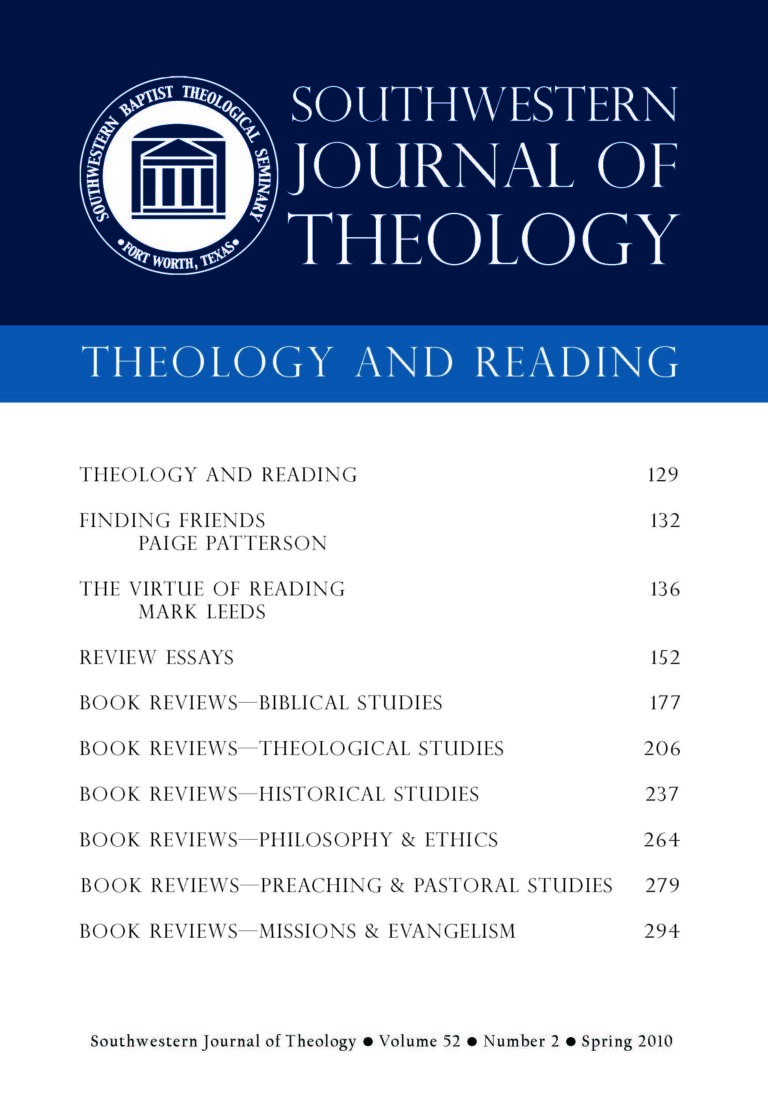
Theology and Reading
Southwestern Journal of Theology
Volume 52, No. 2 – Spring 2010
Managing Editor: Malcolm B. Yarnell III
Edited by Daniel I. Block. Nashville: B&H Academic, 2008. 368 pages. Softcover, $27.99.
The cover of this book with the name Israel and the Star of David leads a reader to assume this is a book about modern Israel or a theological treatise on the role of Israel in eschatology. It is only the subtitle in smaller font that provides the content. The book is a collection of various papers presented at a conference at Southern Baptist Seminary held in 2004. Most of the papers and participants were present at an earlier conference held at Trinity University in 2001 (proceedings published in The Future of Biblical Archaeology: Reassessing Methodologies and Assumptions edited by J. Hoffmeier and A. Millard, Eerdmans 2004).
While Block states that the goal of the book was to address minimalist trends in Bible history and archaeology, none of the papers directly addresses these trends. Nevertheless, there is a conscious undercurrent among the authors concerning these trends within the academy. The uniqueness of this collection is the focus on placing the biblical text within its historical and cultural context using data from ancient texts and the archaeological record.
The editor united the essays into a coherent whole. Each essay deals with a major period in Old Testament history (e.g. Patriarchs, Settlement, Monarchy, etc.). There is an introductory essay addressing the issues of the debate, “Israel— Ancient Kingdom or Late Invention?” This is followed by three essays that deal with methodological issues: “The Value and Limitations of the Bible and Archaeology for Understanding the History of Israel—Some Examples” by Alan Millard, “Contextual Criticism as a Framework for Biblical Interpretation” by John Monson, and “North-West Semitic Inscriptions and Biblical Interpretation: Issues of Provenance” by Joel Drinkard.
The next ten essays deal with specific case studies using data from ancient texts to shed light on the historicity of the biblical text. The essays are: “From Joseph to David: Mari and Israelite Pastoral Traditions” by Daniel Fleming, “Major Geographical Issues in the Accounts of the Exodus: The Pitfalls and Promises of Site Identification in Egypt” by James Hoffmeier, “Slavery and Slave Laws in Ancient Hatti and Israel” by Harry Hoffner, Jr., “Were the Israelites Really Canaanites?” by Alan Millard, “Syria and the Bible: The Luwian Connection” by Richard Hess, “David and Solomon’s Jerusalem: Do the Bible and Archaeology Disagree?” by Alan Millard, “Who Were Israel’s Transjordanian Neighbors and How Did They Differ?” by Gerald Mattingly, “Shalmaneser III and Israel” by K. Lawson Younger, “Did the Israelites Really Learn Their Monotheism in Babylon?” by Simon Sherwin, and “Did Persian Zoroastrianism Influence Judaism?” by Edwin Yamauchi. The last essay, “Interpreting the Bible as an Ancient Near Eastern Document” by John Walton, synthesizes the preceding.
Most of the contributors are primarily textual scholars focusing their research on biblical and ancient Near Eastern texts and history. Only two of the authors are part of current archaeological field projects. Each essay has an introductory abstract and a short bio of the author. The essays are well footnoted and the book contains three indices: names (of scholars), subject, and Scripture references. Maps from the Holman Bible Atlas are distributed throughout the essays where appropriate.
The value of this book is that it brings the work of current evangelical scholars to a wider audience. Each of the essays demonstrates a command of the scholarship as well as a high view of the historicity of Scripture. More importantly, it demonstrates the value of a contextual approach to biblical interpretation. The essays are accessible to non-specialists in the field—hence this is a great resource for seminary students, professors, and laity. It is an excellent overview of scholarly trends, methodological approaches, and research among current evangelical scholars.





